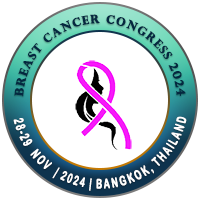
Mohamed Abdelaziz
Fayoum University Hospital, EgyptTitle: Iatrogenic Breast Lymphoedema; Incidence, Diagnosis and Associated Risk Factors
Abstract
Background: While upper limb lymphoedema following breast and axillary surgery is well established in the literature, breast lymphoedema is rarely documented.
Aim: Our primary objective was to identify risk factors of breast lymphoedema, and our secondary aim was to assess the possibility of using a breast ultrasound scan to assess breast lymphedema. Patients and methods: We have conducted a prospective study, including patients who had wide local excision for primary breast cancer treatment between January 2013 to January 2018. Patients’ demographics, including age, weight, and BMI, breast volume, and tumour characteristics, as well as histological findings, were noted. All patients had a clinical assessment and ultrasound scan six months and 12 months after surgery, comparing ipsilateral to the contralateral breast skin, subcutaneous thickness, as well as parenchymal changes.
Results: Two hundred eighty-six female breast cancer patients have been included in our analysis; mean age was 54.7 years SD 17.3, mean 76.5 Kg SD12.6 mean BMI was 31.5 SD 5.2, mean breast volume was 1223 ml SD 179. We have identified breast lymphoedema in patients with clinically detected skin oedema in the absence of radiotherapy skin changes and skin, and subcutaneous 5mm added thickness more than the contralateral side, based on that 7.7% (22 patients) were found to have breast lymphoedema. We have found that patients with high BMI, larger breast volume, upper outer quadrant tumours, and patients who had axillary lymph node clearance had increased incidence of breast lymphoedema. Conclusion: In our cohort incidence of breast, lymphoedema was 7.7%. We suggest that breast lymphoedema should be considered if skin and subcutaneous thickness are 5mm more than the contralateral side in the absence of severe radiotherapy skin changes. We also found that high BMI, larger breast volume, upper outer quadrant tumours, and patients who had axillary lymph node clearance are associated with increased incidence of breast lymphoedema.
Biography
To be updated soon.

